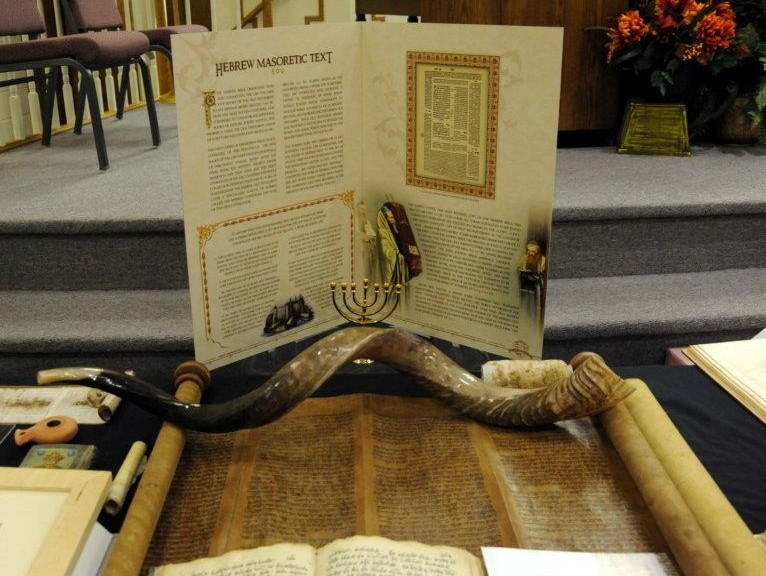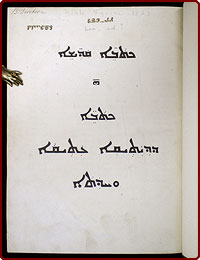
|
|
 |
|
**List: Syriac: Modern Ministry Bible ( Ktaba )
THE SYRO-CHALDAIC VERSION. from the Gospels printed for the B & F Bible Society London--1860 S. Bagster [Info only: ESTRANGELO CHARACTER "18[29?]" John 1:1-14 unknown.]
|

Syriac: Modern Bible History (3) 
**List: Syriac: Modern Ministry
Bible ( Ktaba )
Syriac: Modern...
SYRO-CHALDAIC
AND MODERN SYRIAC."I.--PEOPLE FOR WHOM THIS EDITION IS DESIGNED. THE Syriac language is written in Nestorian characters, by a professedly Christian people, of whom
some are entrenched among the mountains of Assyria, and others settled in the adjacent plain of
Ooroomiah, in West Persia, between 36° and 39° north latitude, and 43° and 46° east longitude: they
are supposed to amount, in point of number, to about 200,000 souls. They are sometimes called
Chaldæans, or East Syrians, from the country they inhabit; but they are more commonly known by
the name of Nestorians, which latter appellation, they contend, is not derived from the celebrated
Nestorius, who was condemned at the third Council of Ephesus, but from Nazareth, the city of Mary.
It is said that they originally fled from the Roman empire, during persecution in the reign of Justinian,
and that they placed themselves under the protection of the king of Persia, who assigned them an
abode in his dominions. They then consisted of 50,000 families, headed by fifty bishops, and the
family of the bishop who then held precedence over the rest, still retains the principal civil and
ecclesiastical power. During the severe persecutions which they subsequently suffered from the
Moh_mm_dans, they were driven to their present impregnable abodes. Their religious tenets are less
corrupted than those of most oriental churches.* They seem never to have practised image worship nor
auricular confession; and so great is their antipathy to popery, that they have a singular and most* A modern visitor of these interesting people observes, "the happy moral influence of Christianity could not be
more plainly manifested than in the change of manners immediately observable in the country we had now entered,
and which presented itself with the more force from its contrast with the sullen ferocity of the Moh_mm_dans. The
kind, cordial manners of the people, and the great respect paid to their clergy, were among the first-fruits of that
influence which showed themselves." Again: "the Chaldæan church neither inculcates seclusion nor celibacy among
its clergy; its only purification is fasting, so strongly enjoined to all Christians," etc.--Ainsworth, 'Visit to the Chal-
dæans, in the summer of 1841,' Journal of Royal Geographical Society, vol. xi. Several American mies. are
stationed in the town of Ooroomiah, or Urumiyah, near the western shore of the lake of that name.anti-christian custom of cursing the Pope regularly every day, his grandfather, grandmother, and
grandchildren.II.--CHARACTERISTICS OF THE LANGUAGE. The language generally denominated the Syro-Chaldaic, or Nestorian, differs in no respect from
the Syriac, unless it be, indeed, in the occasional variation of one or two grammatical forms, and a
difference in the pronunciation of the vowels. Thus a Syro-Chaldaic book, if transcribed in Syriac
characters, would be pure Syriac. The Chaldean priest at Khosrova had a copy of the Pentateuch
which he had caused to be transcribed, word for word, from the Syriac of Walton's Polyglot, only
substituting the Nestorian for the Syriac characters; and it was ascertained beyond doubt by the
mies., that the language of this Pentateuch was perfectly identical with that of the Church books
in common use among the Nestorians. The Nestorian characters may be said to be almost the same as
the ancient Estrangelo, only slightly modified in form; they are very clear and agreeable to the eye,
and mies. stationed in the country, who have been afflicted with ophthalmia, and thereby
deprived of the power of reading English type without pain, have found themselves able to read with
ease and pleasure books written or printed in the Nestorian character. The dialect at present commonly
spoken among the Nestorians is a very corrupted form of their ancient Syriac: it abounds in con-
tractions, abbreviations, and inversions, and is adulterated by Persian, Turkish, and Kurdish words.
In sound it is even harsher than the Armenian. It still, however, retains its character as a Shemitic
dialect; many Arabic and Hebrew words are discoverable in it; and it is rather remarkable, that the
Nestorians and the Jews settled in adjacent villages are able to converse together, although the dialect
spoken by the Jews is a barbarised form of Hebrew, altogether distinct from the vernacular of the
Nestorians."--1860 S. Bagster [Info only]
"III.--EDITIONS OF THE SCRIPTURES IN THIS LANGUAGE. Several ancient MSS. of Scripture have been found in the possession of the Nestorians, which from
time to time have been brought to Europe. Dr. Wolff, during his travels in 1826, purchased of the
Nestorians several MSS. of various portions of their Bible; these he brought safely to England, although
on two several occasions he very narrowly escaped shipwreck. The MSS. became the property of the
London Society for promoting Christianity among the Jews, and the Committee lent them to the
British and Foreign Bible Society for publication. An edition of 2000 copies of the Syro-Chaldaic
Gospels was accordingly printed by the latter Society, under the editorship of T. P. Platt, Esq., and
those passages in which the MSS. were deficient were supplied from the Syriac version; for Mr. Platt
had ascertained, on critical examination, that the Syro-Chaldaic text was identical, or nearly so, with
the Society's Syriac version, the character only being different. The types were cast for the purpose
by Mr. Watts, and the edition left the press in 1829. This, however, was not the first time that Syriac
had been printed in Nestorian characters, for a Syriac liturgical work, called Missale Chaldaicum, con-
taining the selections from the Gospels and Epistles read on Sundays and Festivals, was published in
these characters in 1767 at Rome, accompanied by an interpretation in Carshun. The mies.
now among the Nestorians are said to be engaged in the elaborate preparation of a Syro-Chaldaic Old
Testament, in which they take the ancient and valuable Syriac version, the Peshito, as their text. An
edition of the Scriptures has been projected by the Christian Knowledge Society, from valuable MSS.
collected at the cost of the Society in Mesopotamia: but little, if any, progress seems as yet to have
been made in the publication of this important work. Mr. Perkins, of the American Board of Missions,
commenced, in 1836, a translation from the ancient or ecclesiastical language, into the modernised
corrupt dialect now vernacular among these people. The Gospels, and several tracts and books, together
with a monthly paper, have issued from the press at Ooroomiah; and more recently an edition of
1500 copies of the entire Bible, translated from the Hebrew, in modern Nestorian, with the Syriac in
parallel columns, has been completed."--1860 S. Bagster [Info only]THE SYRO-CHALDAIC VERSION. from the Gospels printed for the B & F Bible Society London--1860 S. Bagster [Info only: ESTRANGELO CHARACTER "18[29?]" John 1:1-14 unknown.]
"IV.--RESULTS OF THE DISSEMINATION OF THIS VERSION. Dr. Wolff, of the London Society for the Conversion of the Jews, travelled, in 1826, among the
Nestorian churches, and had frequent interviews with the priests and people. He found them, as they
themselves admitted, in a wild and uncivilised state; but when questioned on the cause of their want
of civilisation, they acknowledged it to be the result of their lamentable destitution of copies of the
Scriptures. They had no printed copies whatever, and the MSS. were extremely scarce, and never
found in the hands of the common people. "But," said they, "we have heard that the English are
able to write a thousand copies in one day: would they not write for us several thousand copies, and
send them to us? we become wild like Kurds, for we have so few copies of the Bible. The English
have written those of the Jacobites (in Syriac characters) which we cannot read generally, why should
they not write these of ours?" The expectations and desires of these simple people were realized; and
soon after they had been put in possession of the Gospels by the British and Foreign Bible Society, the
divine seed sprang up and bore fruit to the glory of God. The mies. of the American Board of
Missions who have for some years been labouring among them, give the following account of them:
"The light of heavenly truth is rapidly pervading the mass of the people, many of whom appear like
a person awakened from a deep sleep, unconscious of the darkness in which he has been enveloped, and
are inquiring how it is that they have been kept so long in ignorance and self-delusion. To this their
priests reply, ‘We ourselves, till now, have been dead in trespasses and sins; and our criminality is
even greater than yours for having hidden the light so long." The following and later testimony
is to the same purport. "The other day (writes Mr. Barker, in 1853), an American my., who
had been residing sixteen years at Ooroomiah, communicated to me most interesting accounts of the
state of things in that part of the world. In the whole of that district the American mies. have
full liberty to preach in all the Nestorian churches; the Patriarch, who lives in the mountains, no
longer opposing the reformation which is taking place among his people, and his brother is a member
of the American Mission. All the churches have been divested of all their pictures, crosses, etc.,
leaving their walls completely bare, as in Protestant places of worship. The pious Nestorians have
marked out all the objectionable portions of their Liturgy, such asprayers of intercession to the Virgin,
Saints, etc., and omit them in their devotions. In the Ooroomiah district, there are 80 schools entirely
under the control of the mies., amongst which are some for male and female adults.""--The Bible of Every Land. (1860, Second Edition) Samuel Bagster [Info only]
[Christian Helps Ministry (USA)] [Christian Home Bible Course]